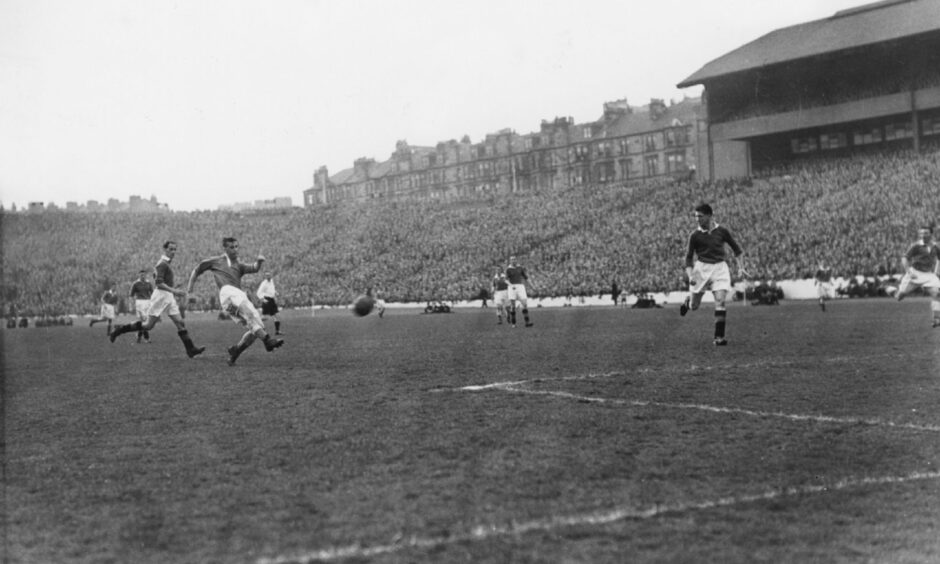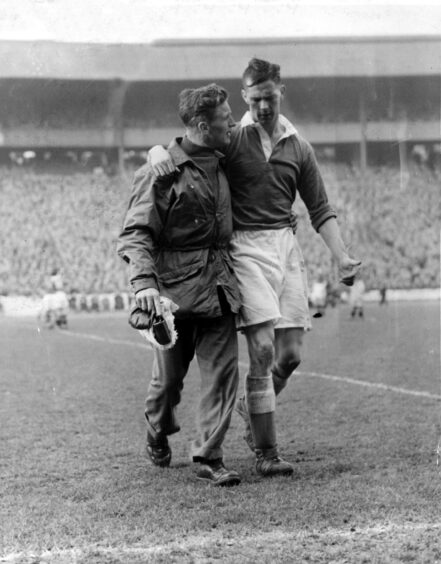
Saturday will be the eighth Scottish Cup final between Aberdeen and Celtic.
The showpiece finale to the Scottish season promises to be a thriller as Jimmy Thelin aims to secure his first trophy as Dons boss.
There have been some remarkable tales surrounding the previous cup final meetings between the sides.
The fixture has provided a record attendance for a club game in the first final meeting in 1937, the absence of Eddie Turnbull from the dugout due to illness in the 1967 final and the first final to be decided on penalties in 1990, to name but a few historic moments.
But you will struggle to find a more incredible tale than the one of the late Joe O’Neil and the role he played in the Dons reaching the 1954 cup final – only to suffer heartache at missing the big game at Hampden.
Skull fracture left O’Neil reeling
O’Neil had declared himself fit for the semi-final against Rangers – despite suffering a depressed fracture of the skull three weeks before the match.
The incident had happened at Pittodrie in a league match against Falkirk 24 days before the cup-tie.
The inside forward, having received medical treatment, got to his feet before staggering uncertainly and collapsing on the pitch prior to being carried from the field and taken to Aberdeen Royal Infirmary.
Recalling the injury, O’Neil told the Press and Journal in 1988: “Centre-half Ralph McKenzie had just recently been transferred from Aberdeen to Falkirk, and I think it was his elbow – although it might have been the goalkeeper – that put a dent in my skull.
“Trainer Davie Shaw led me off round the touchline and I could hear the crowd, but I couldn’t see them. My vision had gone and my senses kept drifting in and out.
“I finished up in hospital with a depressed fracture of the skull.”
Last rites and gruesome skull operation… while O’Neil was still awake
The injury was so grave O’Neil’s son Kevin later revealed his father Joe had been given last rites after the game.
O’Neil said: “You have to think of your skull being like a ping pong ball and they had to bore a hole in it to press out the bit that was dented.
“They couldn’t put me to sleep and I had the operation with a local anaesthetic.”
Dons attacker lied to manager to fulfil Hampden dream
O’Neil was lucky to be alive and the horrendous injury should have ended his season – but he was determined to play in the semi-final against Rangers.
Having been kept in hospital for a week, O’Neil was told he was not allowed to head a football.
But he was having none of it, and begged manager Dave Halliday to play him in the semi-final.
He said: “I kept at Mr Halliday every day, telling him I was okay and wanted to play.
“Finally, the manager said that if the surgeon gave me the all-clear he would play me against Rangers.”
Halliday had put his player in a predicament. Get the all-clear… or pretend he did.
He chose the latter option.
O’Neil said: “I didn’t dare ask the surgeon because he might have ruled me out, but I went back to Mr Halliday and told him that the surgeon had said it was okay for me to play.”
A comeback Roy of the Rovers would be proud of – including headed goal!
It would never happen today, of course, but it came to pass O’Neil – if not quite defying medical advice, given he never sought it – declared he was fit to play.
What followed would have made Roy of the Rovers blush.
The forward scored a hat-trick and won a penalty for his side in an incredible display as Aberdeen inflicted Rangers’ heaviest Scottish Cup defeat with a 6-0 mauling.
O’Neil said: “I remember my three goals as if the game were yesterday – the first was a left-foot shot past Bobby Brown from the left-hand corner of the penalty area.
“No. 2 was a header. I never thought twice about using my head because it wasn’t giving me any pain and I’ve always been a daft soul anyway.
“The third was after a Jack Allister free-kick. I made a diagonal run behind the Rangers’ wall of defenders and when Jackie hit the ball straight, I was right in the clear and I just cracked the ball into the net.”
O’Neil denied a fairytale final appearance due to another injury
O’Neil’s bravery was commendable, but in a cruel and somewhat ironic twist he injured his ankle ligaments in a league game against Rangers at Ibrox the week before the final.
“Rangers made sure I wouldn’t give a repeat performance of that Hampden display” O’Neil recalled.
“There was a fair bit of stick flying about because Rangers were desperate to get their own back for that 6-0 hiding.
“I think it was Willie Woodburn that got me in the ankle and I was never the same after that.”
O’Neil’s absence from Hampden left a void and forced Aberdeen into a gamble of playing centre-half Jim Clunie in attack.
Clunie was not the threat of the man he replaced and the Dons were beaten 2-1 by the Hoops in the final.
Alec Young’s own goal put Celtic ahead, but the Dons equalised within a minute as Paddy Buckley beat goalkeeper John Bonnar to level the game.
However, Sean Fallon’s close-range finish secured victory for the Glasgow side.
O’Neil said: “There were no substitutes in those days, of course, and I sat there praying for a draw because I was sure that Mr Halliday would put me in for the replay.
“But I still think the boss was wrong to gamble on Clunie instead of my fitness.
“Without wanting to sound big-headed, I felt I could have played better on one good leg than Clunie could with two.”
O’Neil put the disappointment of missing the final behind him as he helped the Dons win the league title in 1955 before moving to Leicester City and then to Bath.
He died in 2005, aged 73.

Conversation